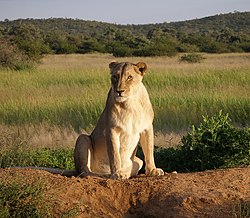The lion (Panthera leo) is a member of the familyFelidae and one of four big cats in the genusPanthera. With some males exceeding 250 kg (550 lb) in weight, it is the second-largest living cat after the tiger. Wild lions currently exist inSub-Saharan Africa and in Asia with a critically endangered remnant population in northwestIndia, having disappeared from North Africa, theMiddle East, and Western Asia in historic times. Until the late Pleistocene (about 10,000 years ago), the lion was the most widespread large land mammal beside humans. They were found in most of Africa, much of Eurasia from western Europe to India and, in the Americas, from theYukon to Peru.
Female (Lioness)
Should they survive the rigors of cubhood, lionesses in secure habitat such as Kruger National Park may frequently reach an age of 12–14 years whereas lions seldom live for longer than 8 years. However, there are records of lionesses living for up to 20 years in the wild. In captivity both male and female lions can live for over 20 years. They typically inhabit savanna andgrassland, although they may take to bush andforest. Lions are unusually social compared to other cats. A pride of lions consists of related females and offspring and a small number of adult males. Groups of female lions typically hunt together, preying mostly on large ungulates. The lion is an apex and keystone predator, although they will resort to scavenging if the opportunity arises. While lions, in general, do not selectively hunt humans, some have been known to become man-eaters and seek human prey.
The lion is a vulnerable species, having seen a possibly irreversible population decline of 30 to 50 percent over the past two decades in its African range; populations are untenable outside designated reserves and national parks. Although the cause of the decline is not well understood, habitat loss and conflicts with humans are currently the greatest causes of concern. Lions have been kept in menageries since Roman times and have been a key species sought after and exhibited in zoos the world over since the late eighteenth century. Zoos are cooperating worldwide in breeding programs for the endangered Asiatic subspecies.
Visually, the male is highly distinctive and is easily recognized by its mane. The head of the male lion is one of the most widely recognized animal symbols in human culture. It has been depicted extensively in literature, in sculptures, inpaintings, on national flags, and in contemporary films and literature. Sometimes the image of the males is used, even when the female is intended, because the distinctive mane differentiates the species from other large feline species.
The lioness has been recognized, however, as the pinnacle of hunting prowess from the earliest of human writings and graphic representations. The lionesses are the hunters for their pride and capture their prey with precise and complex teamwork. Each lioness develops specific skills for her role in the hunting techniques used by her pride and, generally, assumes that role during most hunts. Depictions of lionesses hunting in groups have existed from the Upper Paleolithicperiod, with carvings and paintings from theLascaux and Chauvet Caves.
Members of human cultures living among lions in natural habitats have understood this characteristic and often have chosen the lioness to represent their most ferocious war deities and warriors, often naming their male rulers as her "son". Examples drawn from the earliest of written records include the Egyptian pantheon deities of Sekhmet, Bast, Menhit, and Tefnut, and these deities may have had precursors in Nubia andLybia. Other Egyptian deities are quite complex and assume aspects that may include one as a lioness headed human or a lioness in specific roles.
Many images created to represent fierce, large feline animals described as leopards and panthers reveal their identity as lionesses when the tail is examined. The characteristic tuft belongs only to lionesses if there is no mane—no matter what they are called by modern interpreters. The presence of spots may not differentiate them either, since young lions often have spots in a rosette pattern, the tail must be examined to exclude the lioness from many mislabeled images.
(wikipedia.org)


No comments:
Post a Comment